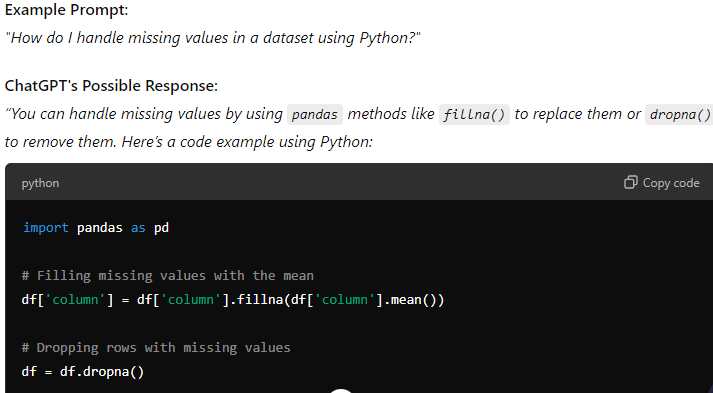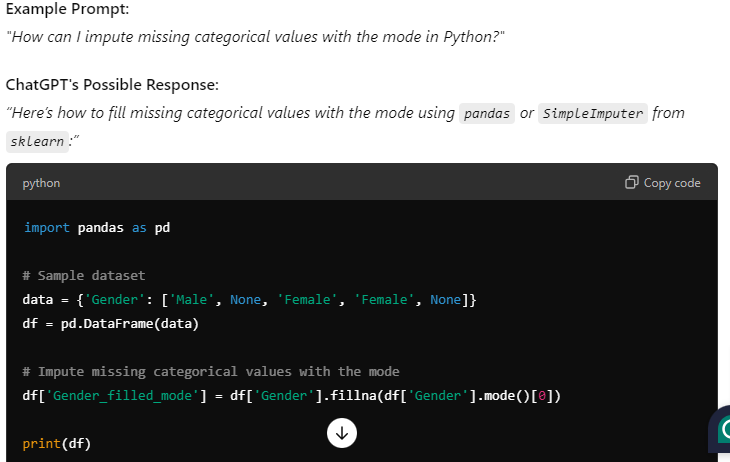How to Use ChatGPT as a Data Scientist?
Last Updated :
27 Sep, 2024
As a data scientist, you can leverage ChatGPT as a valuable tool to streamline various tasks, enhance productivity, and generate insights more efficiently. Whether you're cleaning data, developing models, or reporting results, ChatGPT offers ways to automate and enhance your workflow. ChatGPT, a large language model developed by OpenAI, has advanced capabilities beyond text generation. As a data scientist, you can utilize ChatGPT to accelerate various aspects of your work. From assisting in coding tasks to generating insights from data, ChatGPT can transform your daily routine.
 How to Use ChatGPT as a Data Scientist?
How to Use ChatGPT as a Data Scientist?In this article, we will explore the different areas where ChatGPT can assist data scientists, from data preprocessing to model building, evaluation, and collaboration.
ChatGPT for Data Preprocessing
Data Cleaning
Data preprocessing is one of the most time-consuming tasks in data science. ChatGPT can assist by helping you write functions for:
- Handling missing data (e.g., imputing values, removing missing entries)
- Detecting outliers
- Standardizing and normalizing data
 Example 1
Example 1Data transformation tasks such as encoding categorical variables or scaling numeric features can also be automated with the help of ChatGPT. You can prompt it to:
- Provide Python code for one-hot encoding
- Help with log-transforming skewed data
- Generate code snippets for data normalization or standardization
 Example 2
Example 2ChatGPT for Exploratory Data Analysis (EDA)
Descriptive Statistics
You can use ChatGPT to help you quickly generate descriptive statistics. It can:
- Create code to compute measures like mean, median, mode, standard deviation, and percentiles.
- Help identify distribution trends in your dataset.
 Example 3
Example 3Data Visualization Assistance
Data visualization is a key part of EDA. ChatGPT can:
- Write code snippets to generate charts (e.g., histograms, box plots, scatter plots) using libraries like Matplotlib and Seaborn.
- Assist in explaining what each visualization reveals about the data (e.g., distribution, correlation between variables).
 Example 4
Example 4ChatGPT for Data Wrangling and Feature Engineering
Handling Missing Data
Cleaning and imputing missing values is a crucial step in data wrangling. ChatGPT can provide various strategies and corresponding code to address missing data. For instance, it can:
- Generate code for imputing missing values based on statistical methods or machine learning models.
- Help create pipelines that handle missing data efficiently.
 Example 5
Example 5Feature Selection and Creation
Feature engineering is often complex, but ChatGPT can assist with:
- Recommending new features based on existing ones.
- Writing code for feature scaling, polynomial feature creation, or interaction terms.
- Providing techniques like Recursive Feature Elimination (RFE) or Principal Component Analysis (PCA) to select the best features.
 Example 5
Example 5ChatGPT for Model Building
Model Recommendations
Based on your problem type (classification, regression, clustering, etc.), ChatGPT can:
 Example 6
Example 6Hyperparameter Tuning
ChatGPT can also help optimize your models by:
- Suggesting methods like Grid Search or Randomized Search for hyperparameter tuning.
- Generating code that automates hyperparameter optimization using tools like Scikit-learn’s GridSearchCV or RandomizedSearchCV.
Example Prompt:
"How can I use GridSearchCV to tune hyperparameters for my Random Forest model?"
 Example 7
Example 7ChatGPT for Model Evaluation and Validation
Once the model is built, evaluating it with the correct metrics is essential. ChatGPT can assist in:
- Choosing appropriate performance metrics (e.g., accuracy, precision, recall, F1 score, ROC-AUC for classification, or R-squared for regression).
- Generating Python code for calculating and visualizing these metrics.
Example Prompt for Regression:
"Can you generate code to evaluate a regression model using R-squared, MSE, RMSE, and MAE?"
 Example 8
Example 8 Cross-Validation
For robust model evaluation, cross-validation is crucial. You can use ChatGPT to:
- Create cross-validation pipelines.
- Evaluate your model's performance using techniques such as k-fold cross-validation or leave-one-out cross-validation.
Example Prompt:
"Can you help me implement k-fold cross-validation in Python for a classification model?"
 Example 9
Example 9 ChatGPT for Documentation and Reporting
Code Documentation
- Automatically generate docstrings for your functions and classes.
- Provide explanations for complex code segments, making it easier for others to understand.
Report Writing
ChatGPT can generate sections of reports summarizing data analysis results. It can:
- Produce text summaries of findings, key metrics, and visualizations.
- Help write comprehensive project reports, explaining model results and implications.
ChatGPT for Collaboration and Knowledge Sharing
Explaining Concepts to Non-Technical Stakeholders
Data scientists often need to present findings to non-technical stakeholders. ChatGPT can help:
- Translate complex statistical or machine learning concepts into simple, easy-to-understand language.
- Draft concise explanations that make it easier to communicate insights.
Conclusion
Incorporating ChatGPT into your data science workflow can significantly enhance productivity, streamline processes, and foster creativity. By leveraging its capabilities in data exploration, preprocessing, model development, evaluation, and collaboration, data scientists can focus more on analysis and less on repetitive tasks. As AI continues to evolve, tools like ChatGPT will play an increasingly vital role in empowering data scientists to achieve more with less effort. Embrace this innovative technology and take your data science projects to new heights!
Similar Reads
Non-linear Components In electrical circuits, Non-linear Components are electronic devices that need an external power source to operate actively. Non-Linear Components are those that are changed with respect to the voltage and current. Elements that do not follow ohm's law are called Non-linear Components. Non-linear Co
11 min read
Spring Boot Tutorial Spring Boot is a Java framework that makes it easier to create and run Java applications. It simplifies the configuration and setup process, allowing developers to focus more on writing code for their applications. This Spring Boot Tutorial is a comprehensive guide that covers both basic and advance
10 min read
Class Diagram | Unified Modeling Language (UML) A UML class diagram is a visual tool that represents the structure of a system by showing its classes, attributes, methods, and the relationships between them. It helps everyone involved in a project—like developers and designers—understand how the system is organized and how its components interact
12 min read
Backpropagation in Neural Network Back Propagation is also known as "Backward Propagation of Errors" is a method used to train neural network . Its goal is to reduce the difference between the model’s predicted output and the actual output by adjusting the weights and biases in the network.It works iteratively to adjust weights and
9 min read
3-Phase Inverter An inverter is a fundamental electrical device designed primarily for the conversion of direct current into alternating current . This versatile device , also known as a variable frequency drive , plays a vital role in a wide range of applications , including variable frequency drives and high power
13 min read
Polymorphism in Java Polymorphism in Java is one of the core concepts in object-oriented programming (OOP) that allows objects to behave differently based on their specific class type. The word polymorphism means having many forms, and it comes from the Greek words poly (many) and morph (forms), this means one entity ca
7 min read
CTE in SQL In SQL, a Common Table Expression (CTE) is an essential tool for simplifying complex queries and making them more readable. By defining temporary result sets that can be referenced multiple times, a CTE in SQL allows developers to break down complicated logic into manageable parts. CTEs help with hi
6 min read
What is Vacuum Circuit Breaker? A vacuum circuit breaker is a type of breaker that utilizes a vacuum as the medium to extinguish electrical arcs. Within this circuit breaker, there is a vacuum interrupter that houses the stationary and mobile contacts in a permanently sealed enclosure. When the contacts are separated in a high vac
13 min read
Python Variables In Python, variables are used to store data that can be referenced and manipulated during program execution. A variable is essentially a name that is assigned to a value. Unlike many other programming languages, Python variables do not require explicit declaration of type. The type of the variable i
6 min read
Spring Boot Interview Questions and Answers Spring Boot is a Java-based framework used to develop stand-alone, production-ready applications with minimal configuration. Introduced by Pivotal in 2014, it simplifies the development of Spring applications by offering embedded servers, auto-configuration, and fast startup. Many top companies, inc
15+ min read